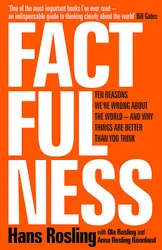This is a book about the state of the world today (or at least in 2017 when it was written), particularly in the area of poverty, living standards, health and life expectancy. It also covers the ways in which our understanding and knowledge of the world haven’t kept up with the progress being made in these areas, the reasons for why this is, and how we can better keep ourselves correctly informed. It also aims to replace the old, obsolete idea of a developed and a developing world with a more nuanced model of 4 levels of income that better represent the state of the world.
I wouldn’t describe this as a science book, really. But the fundamental idea of collecting data, and interpreting that data to give us a better understanding of how things really are, rather than relying on our intuitions, is a very scientific mindset.
The book starts with a questionnaire about the state of the world, and throughout the book it emphasises how many people (including experts in relevant fields) get the answers wrong. Each chapter then covers a different instinct that we have that can lead us to misunderstand the world, how this occurs and how we can counteract it with a more “factful” way of thinking.
I learned that lots of my own ideas about the state of the world were wrong or out of date. I was pleasantly surprised to learn that the number of people in extreme poverty (level 1) has been going steadily down, and key indicators like life expectancy and infant mortality have been improving right across the world.
Because the book emphasises the positive changes that have occurred, it’s actually quite an uplifting, comforting book to read. Following the news, you can get the impression that the world is in a terrible state and getting worse. The book explains why our media tend to focus on extreme negative events which aren’t representative of the steady progress that has been made so far. This book helped me to realise that there has been a slow but steady movement out of extreme poverty for large numbers of people in the world, as well as other improvements.
The book contains lots of good graphs and charts that help to illustrate the positive changes that have occurred, or to show how bad charts can give you a biased view of some change.
The primary author, Hans Rosling, died before this book was published, and it was completed by his son Ola Rosling and daughter-in-law Anna Rosling Rönnlund. However, it’s written primarily in Hans Rosling’s voice, and includes lots of personal anecdotes from his career, including as a doctor in some very poor countries, where his decision making in the moment didn’t live up to his later ideals about “factfulness”. He admits to mistakes made in the heat of the moment, and describes the consequences of these mistakes, some of which resulted in preventable loss of life.
The author is clear that we still need to keep improving things for the people in the lower income levels. In 2017, there were more people in the world living in level 2 than in levels 3 or 4, and from my perspective in level 4, this looks like poverty, even if it’s better than level 1 poverty. The book is definitely not about becoming complacent and assuming that positive change will just happen. The author has a mantra of “bad and better” to remind himself that things can be bad (the poverty and suffering we still see in the world) and better (better than they used to be and still improving).
Clearly not every trend in the world is positive. The negative ones I’m most aware of are related to the environment and climate change, but I’m sure there are others. The message of the book is not simply that “everything is fine” but it doesn’t have all that much to say on how to handle data that is clearly pointing in a negative direction. It does make the point that drumming up as much fear as possible (particularly around climate change) may be counter-productive. But I think it would have been useful if book had included material about how to maintain positivity when considering changes that are moving in the wrong direction. How can we apply a factful way of thinking in these situations, to find the most effective action we can take, or to keep ourselves motivated?
I would definitely recommend this book to anyone with an interest in the state of the world who wants to be better informed, or who is feeling down about the state of the world and wants to counteract the negativity they see in the news.
